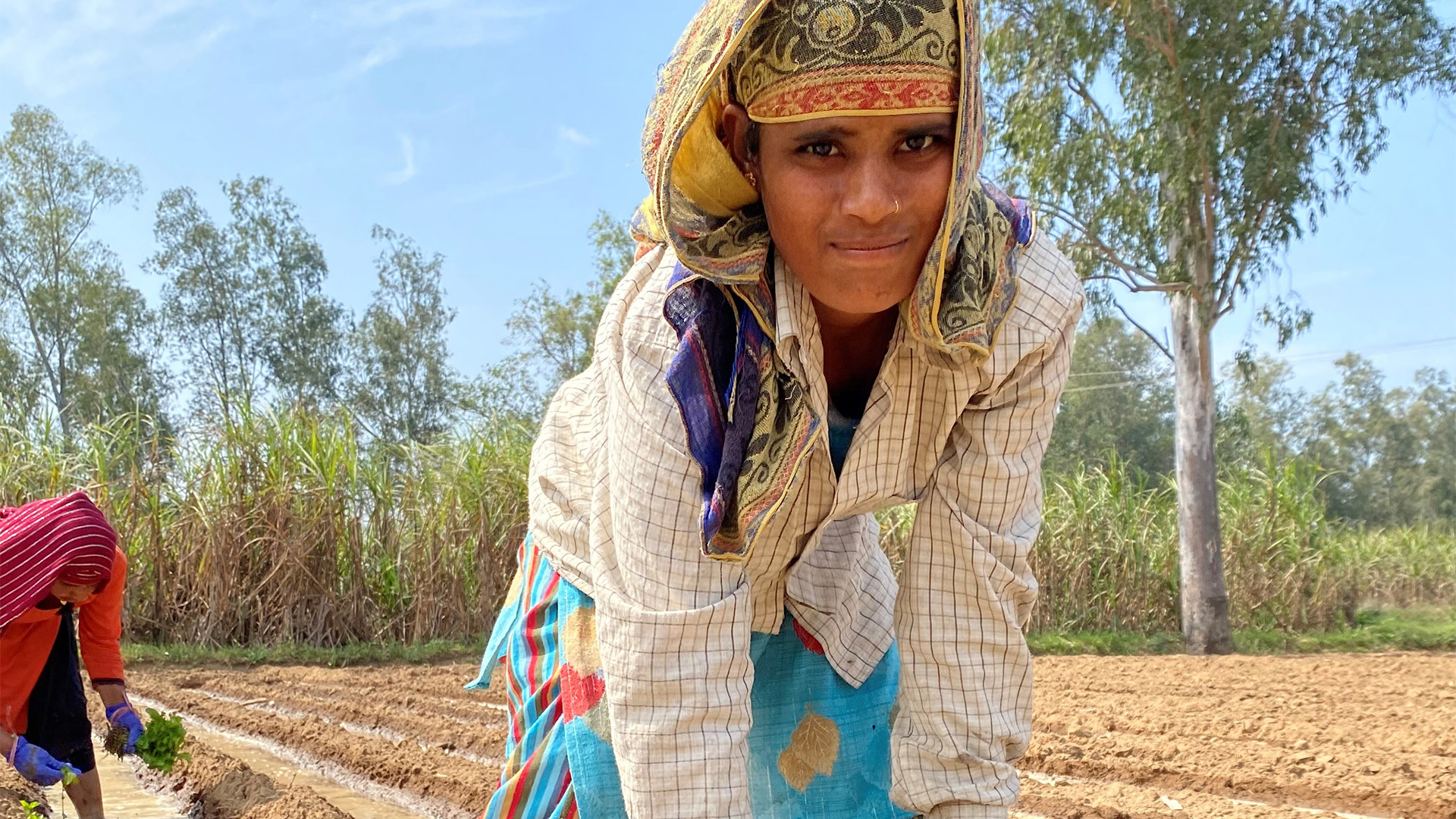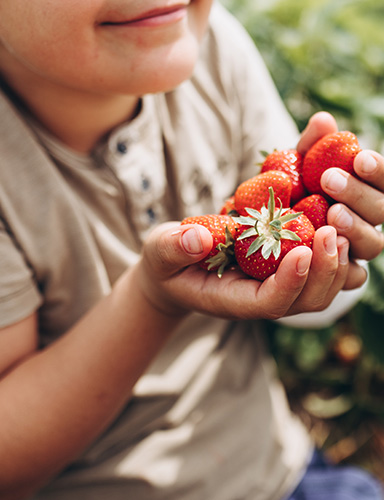Our procurement and responsible sourcing teams are working closely with Norex, our local partner in India, to support innovation, establish best farming practices, and empower smallholders. This involves helping to secure smallholders’ living conditions while at the same time ensuring a sustainable supply of high-quality mint.
Eighty-five percent of the world’s mint used in oral care and confectionery products is grown in India. This figure includes 95% of all Mentha arvensis, the most widely used variety, which is grown by approximately 2 million Indian smallholders, mainly in Uttar Pradesh. This is one of the most important states for Indian agriculture, yet one of the lowest-ranking in terms of socio-economic development.
‘The golden crop’
In Uttar Pradesh, the ‘golden crop’, as it is known, is one of the main sources of income for local households. Mint leaves are dried and distilled by villagers, thereby adding value to the harvested product. The sustainability of this supply chain is therefore just as crucial for providing livelihoods to smallholders as it is for guaranteeing reliable supplies of high-quality Mentha arvensis to our customers. Ninety-five percent of our annual needs for natural menthol and Mentha arvensis oil comes from eight suppliers in the state. This includes all of our menthol.
Furthermore, one of those suppliers, which currently accounts for 7% of all our mint products (by volume), is at the heart of a unique, 360-degree responsible sourcing project. We aim to increase their contribution significantly over the coming years.

Empowering local smallholders
At dsm-firmenich, we always seek to increase the sustainability of our supply chains. By tackling both the environmental and the social dimensions of mint production, this project aims to empower local smallholders and create synergies that can enhance their earning potential and consequent economic resilience.
On the one hand, we strive to improve soil management techniques by embedding agricultural innovations into traditional farming practices to reduce irrigation needs and increase climate resilience. We aim to drive down production costs while raising yields sustainably, because improving farmers’ profit margins is the key to ensuring a viable income from mint cultivation. This involves not only improvements in farming practices but also – through the professionalization of techniques and the modernization of facilities – improving yields and at the same time enhancing the quality of crude mint oil by means of local distillation.
On the other hand, given the specific context of Uttar Pradesh, the provision of greater opportunities for all, especially women and young people, is designed to further strengthen local livelihoods. This is why, besides technical support, we work at the level of the individual household by helping to cultivate entrepreneurial skills, support income diversification, provide access to existing social schemes, and enable gender equality.
Applying our ‘Sustainability at Source’ philosophy
Our purpose encouraged us to evaluate the best opportunities to implement our ‘Sustainability at source’ philosophy, tailored to the specific needs of the mint supply chain. We were aware that there was only one initiative for sustainable mint-sourcing, in the eastern area of Uttar Pradesh, despite the state’s global significance for the sourcing of mint.
Instead, we chose to work in the western part of the state to leverage an innovative solution developed by a local research institute – the Central Institute of Medicinal and Aromatic Plants (CIMAP). The project was designed to enable the cultivation of sustainable, digitally traceable, and natural products that would provide viable livelihoods to 3,000 smallholders, 20 distillers and 180 workers and their households.
To harness digital data collection and a rigorous monitoring and evaluation framework, we engaged one of our key suppliers, two customers with a major mint footprint (Haleon and Unilever), and public-sector partners (the Foreign, Commonwealth & Development Office of the United Kingdom, Seva Trust as local NGO and an Indian research institute), They contribute funding, expertise, and field support during the course of the four-year project.
A pilot project in 2023 tested our model in real-life conditions. It achieved concrete initial results that will be ramped up in the coming three years.
A three-pillar approach
Co-led by dsm-firmenich and its suppliers directly at source, the project is run by a specially recruited and trained management team.
The first pillar aims to promote a new agricultural model for the sustainable cultivation of mint. The farming package includes improved variety and growing guidelines developed by CIMAP, and the promotion of regenerative agriculture. It is expected to provide measurable benefits including greater resilience to climate change, improved soil quality, and higher yields. Good Health & Safety practices are promoted through all training activities.
Farmers receive training and advice from field officers, but they also benefit from a network of champions selected from top-performing and volunteer farmers. These champions in turn showcase best practices on demonstration plots and advise on the management of nurseries, helping to encourage a sense of ownership ‘by farmers, for farmers’ and to ensure continuity beyond the duration of the project itself. The second pillar targets entire households, including women and young people. A key tool is the Gender Action Learning System (GALS), as it creates the synergy between agriculture, income diversification, and the empowerment of women.
Through this community-led empowerment, we promote crop and income diversification and entrepreneurship along with gender equality.
People with low literacy levels receive help to develop themselves professionally in a project of their own design, which they build and implement with the support of trainers and coaches. This concrete educational approach is backed by other socioeconomic activities that help vulnerable households to access existing rights and entitlements, such as widows’ pensions, education scholarships, and health cards, thereby strengthening their livelihoods. It is supported by an awareness-raising program about the prevention of child labor, along with educational activities targeting local young people.
Finally, our third pillar aims at tackling distillation issues regarding yield and quality. A facility improvement program covers 20 units and their respective workers, who will benefit from capacity-buildingto ensure that they are trained in good distillation practices, operate in safe conditions, and work within a shift system.
Successful pilot project
In 2023, our pilot project for the sustainable production of Mentha arvensis in Uttar Pradesh involved 537 farmers, including 50 champions, who received free planting material, and 20 demonstration plots were set up. The highlights of the project were as follows:
- Around 23% of farmers received full training on the mint model and over 60% followed at least one training course in regenerative agriculture
- The model was fully adopted by almost 100 farmers (including the 50 champions). Partial adoption is usually linked to limits in soil preparation or the ability to achieve a double harvest
- The pilot project’s target of a crude oil yield of 50 kg per acre (based on CIMAP’s hypothesis and average yield in the area) was exceeded, reaching an average of 54 kg per acre. More than 60% of farmers demonstrated yields above target. Overall, the farmers demonstrated a yield increase of 7%
- Ninety percent of the crude mint oil produced by farmers was sold to Norex, as opposed to the usual 4O–50%
- Improvements in a pilot distillation unit enhanced crude mint oil quality (improved color and a 5-10% increase in oil recovery) and enabled a 10% reduction in water use
- Twenty champions and 131 households were trained in GALS, and all farmers were provided with advice on social welfare support. Most of the GALS tools were described as highly useful by 65% of the GALS champions, who stated that their behavior changed most regarding savings (45%) and gender roles in decision-making (55%)




